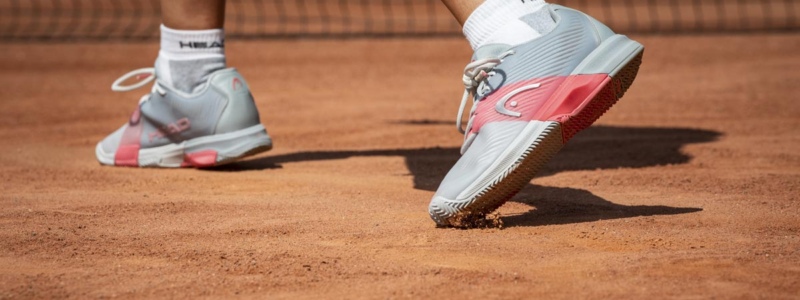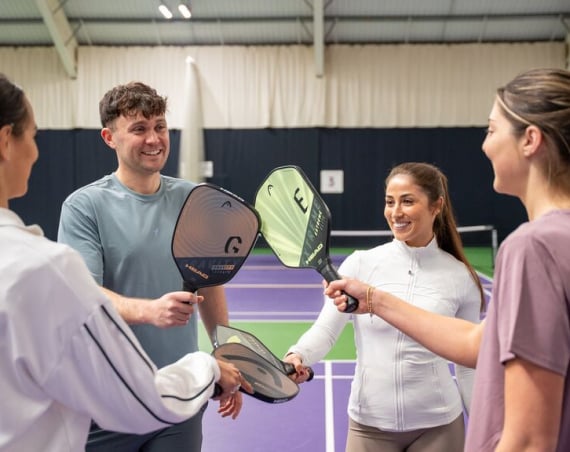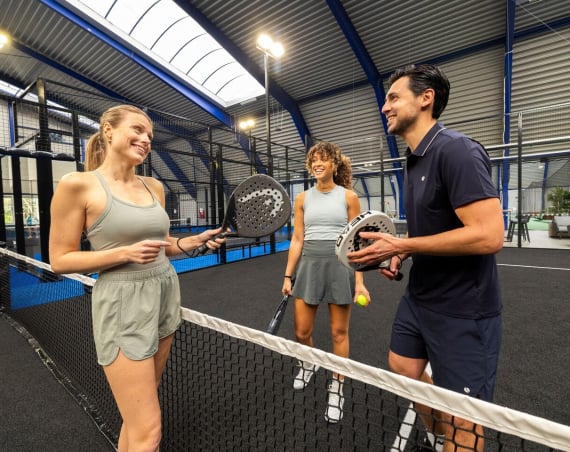From sprinting, jumping and stopping to moving side-to-side, tennis is a demanding sport that requires you to be quick on your feet. That’s why you need proper footwear that can keep up. Just like positive affirmations, selecting the right tennis shoes can give you the comfort, support and stability you need to get the most from your game.
But how do you determine which pair of tennis shoes is right for you? Let’s dive deeper into why tennis shoes are important and what to look for when buying tennis shoes, so you can get the right pair for your unique needs.
3 key factors to consider when buying tennis shoes
Today, you’ve got your choice of countless tennis shoes in all shapes, sizes, and colours. So, how do you know which pair to pick? Here’s what to consider when shopping for tennis shoes, so you can get the right pair for your needs.
1. Tennis surface
Which tennis surface do you play on the most? This can have a big impact on the type of tennis shoes you buy. Each surface plays a little differently, which can change your game and footwork. Wearing a tennis shoe that’s designed specifically to handle the demands of the surface you’re playing on can ensure you maintain optimal footing and help avoid injury.
Hard: The hard court is the most common tennis court surface. It’s also the most demanding regarding the durability of the outsole (the bottommost part of a shoe that comes in direct contact with the ground). Most hard-court outsoles feature a modified herringbone pattern, giving them the perfect blend of grip and give. Hard-court shoes also typically include a tough upper for stability and ample cushioning for comfort against an unforgiving surface.
Clay: Made from shale, brick, or stone, the clay court surface is a loose one. A clay-court outsole usually features a full herringbone (zig zag) tread pattern, which provides a great grip while also preventing clay from getting stuck to the treads. The herringbone pattern also makes both forward-backwards and side-to-side movement easy on the court.
Grass: While grass courts aren’t as common due to the high level of upkeep required, they do have the benefit of being softer on your joints. However, the game tends to play fast and the surface can often get slippery. To contend with this, grass-court outsoles feature protruding nubs (similar to cleats) that provide a solid grip on an unpredictable surface.
Carpet: Unlike other tennis shoes, shoes made for indoor carpet courts feature a smooth outsole without any pattern. This helps prevent tiny particles and small stones from clinging to the sole. Most importantly, it provides the right amount of grip. Wearing any other type of tennis shoe on this surface gives too much grip, which can lead to injury.
If you know you’ll be spending most of your playing time on one specific surface, it’s best to get a shoe designed for that particular purpose. On the other hand, if you’re just taking up tennis for the first time and haven’t decided which surface you prefer, you may want to invest in a good pair of all-court tennis shoes, which are designed to be effective in a variety of playing environments.
2. Your playing style
How do you move around on the court? Are you sprinting from corner to corner, or do usually stick to the baseline? Here are the three main types of playing styles in tennis and what to look for in a shoe based on each style:
Baseline: Baseline players primarily play along the back line of the court, which means a lot of short sprints and lateral movement. Look for a stability shoe with great lateral support for all that side-to-side movement.
Serve-and-volley: A serve-and-volley player frequently charges the net, which means a lot of quick forward and backward movement. Look for a lightweight, flexible shoe for maximum speed and movement. This type of player also tends to slide their back foot along the court while serving, so a shoe with toe protection is essential.
All-court: All-court players move to all sides and corners of the court, which means plenty of back-and-forths and side-to-side movement. Look for lightweight, durable shoes with a good grip, especially if you’re zipping around on a soft court surface.
3. Your foot type
There are three different foot types: neutral arch, low arch, and high arch. The type of arch you have affects how your feet roll (pronate) while walking or running. Knowing your foot type can help you choose a tennis shoe that best supports the natural movement of your foot.
Neutral arch (normal pronation): A neutral arch supports your body weight and rolls in normally. While most shoes are suitable for this foot type, a stable tennis shoe can offer cushioning and support.
Low arch (overpronation): A low arch causes the foot to roll excessively inward (overpronate) with each stride. Look for tennis shoes with maximum arch support, lateral support, cushioning, and stability, which will help keep the arches from collapsing or rotating inward.
High arch (under pronation): A high arch causes the foot to roll slightly outward (under pronate) with each stride. Opt for tennis shoes with good cushioning, flexibility, a low to mid-level arch, and maximum durability to help prevent the feet and ankles from rolling outward.
Not sure which foot type you have? Check the wear on the bottom of your old running shoes:
- Even signs of wear: You likely have a neutral arch and pronate normally.
- Excessive wear on the inner soles: You’re an overpronator and likely have a low arch.
- Excessive wear on the outer soles: You’re an underpronator and likely have a high arch.
- Can’t I just wear my regular trainers?
- In short, no. Tennis shoes and running shoes are each designed for a specific purpose, which means they’re built differently. Running shoes are designed to support the forward movement, while tennis shoes are designed to provide stability for frequent side-to-side (lateral) movement on the court.
Can’t I just wear my regular trainers?
In short, no. Tennis shoes and running shoes are each designed for a specific purpose, which means they’re built differently. Running shoes are designed to support the forward movement, while tennis shoes are designed to provide stability for frequent side-to-side (lateral) movement on the court.
Because you’re not getting the specific support you need, wearing regular trainers on the court could lead to injury. If you plan on playing tennis regularly, be sure to invest in a good pair of tennis shoes. Your feet, body and tennis game will thank you!
Do tennis shoes need to be white?
Nope! Unless you’re competing at Wimbledon, which has a strict all-white dress code, you can wear any colour of tennis shoes you like. In the past, many tennis clubs prohibited black-soled shoes, as they used to mark up the court. However, most modern tennis shoes have non-marking soles, regardless of the colour. As long as your shoes don’t leave marks on the court, you’re free to choose the colours you love most.
Should my tennis shoes be tight or loose?
Your footwear should provide a secure, comfortable fit, neither too tight nor too loose. Consider the following factors when you’re trying on a new pair:
Toe room: There should be about a thumb’s width between the end of your longest toe and the end of the shoe. This gives your foot room to move and flex without rubbing against the shoe.
Width: The shoe should fit your foot snugly, but not tightly, in the midfoot and heel. It should not pinch or squeeze your foot, but it should also not be so loose that your foot slides inside the shoe.
Heel fit: The heel should not slip out of the shoe when you’re moving. Some slippage is normal when you’re trying the shoe on, but it should stop once the shoe is properly broken in.
Comfort: Comfort is critical. Even if a shoe has the right length and width, if it’s not comfortable, it’s not the right shoe for you!
What about tennis socks?
Often overlooked, tennis socks are just as important as the rest of your equipment. A good pair of tennis socks will provide support, comfort, and cushioning in all the right places, minimising the friction that causes blisters. Look for tennis socks with moisture-wicking properties to help keep your feet dry while you play.
If you’ve ever wondered why some tennis players wear their socks so high, it’s for good reason. Longer (crew-cut) socks absorb more sweat, provide protection from dirt and debris, and are generally considered to be more comfortable than low-cut socks. That said, every player is different, so you might want to give both low-cut and crew-cut tennis socks a try to see which one you like best.
Elevate your game at David Lloyd Clubs
From learning the basics to perfecting your technique, you can get your tennis fix all year round at our indoor and outdoor courts. With more than 850 match-quality courts across our clubs, it’s easy to join a thriving tennis community.
Learn more about tennis at David Lloyd Clubs or find a club near you now.
Find a club



